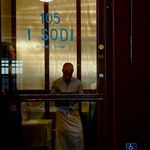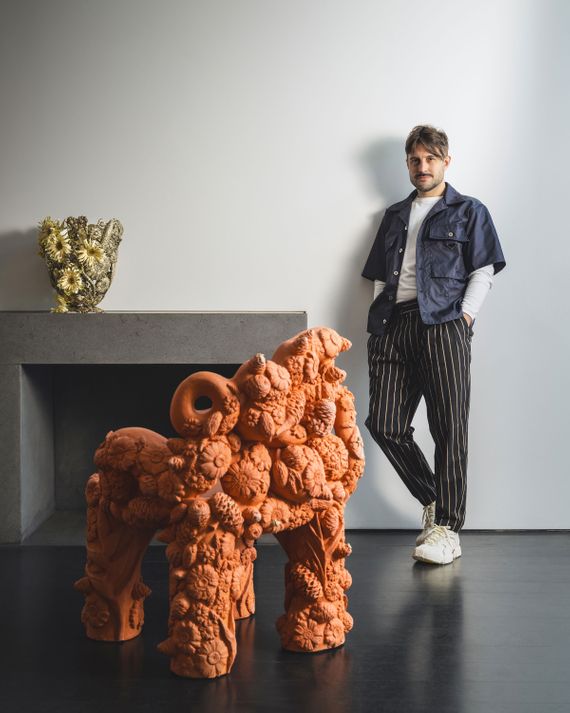
For the past ten years, the designer Chris Wolston has worked in Medellín, Colombia. He’s moved a few times within the city, but for the past three years, his studio has been in a 1920s house in the Prado Centro neighborhood, an older (and rougher) section of downtown filled with colonial buildings. His workspace also shows its age, with earthen walls painted cobalt blue, orange-and-red-tile floors, and a thatched roof made from grass and bamboo. He didn’t change much when he moved in and it’s a fitting environment for the highly tactile furniture and objects Wolston creates there. In a corner, there are six-foot-long bundles of yaré, a vine that grows in the jungle, waiting to be woven into cabinets and loungers, and in another room there’s a massive block of terra-cotta (Wolston orders the material two tons at a time), dug straight from a mountainside a couple hundred miles away. His shelves are lined with cast-aluminum vessels forged at a foundry a few blocks from the studio and there are wax models of flowers waiting to be cast into bronze.
The designer is particularly fascinated by how different regions around the globe have used materials like clay and natural fibers. “I’m a total material nerd,” he says. He points out that the technique for weaving a rattan chair in Indonesia is very distinct from the one used to make a yaré seat in Colombia, even though they’re both considered “wicker.” His inquiry into these material techniques began with his glassmaking studies at RISD and continued during his 2014 Fulbright research into the small-scale manufacturing of household products in Medellín, which looked at items like aluminum chocolate pitchers and terra-cotta bricks. Today, his practice mixes that ongoing research with irreverent, maximalist forms. His Nalgona series of chairs are made using a weaving technique that has pre-Columbian roots, but their shapes are a campy tribute to big butts and body parts. Similarly, his Lost in Paradise collection of cabinets, tables, and chandeliers are a shimmery explosion of multi-colored monstera leaves, calla lilies, and ferns made out of sand-casted aluminum, another technique that goes back millennia. Wolston even named a coffee table that looks like a dozen legs squished together after an orgy.
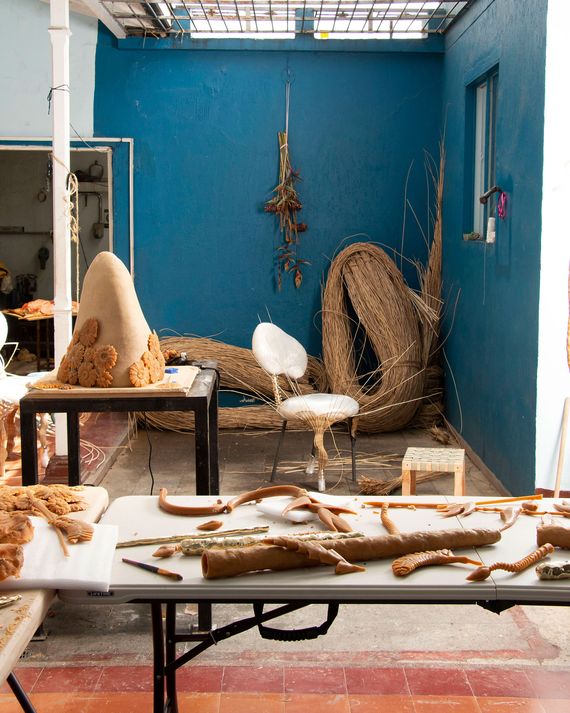
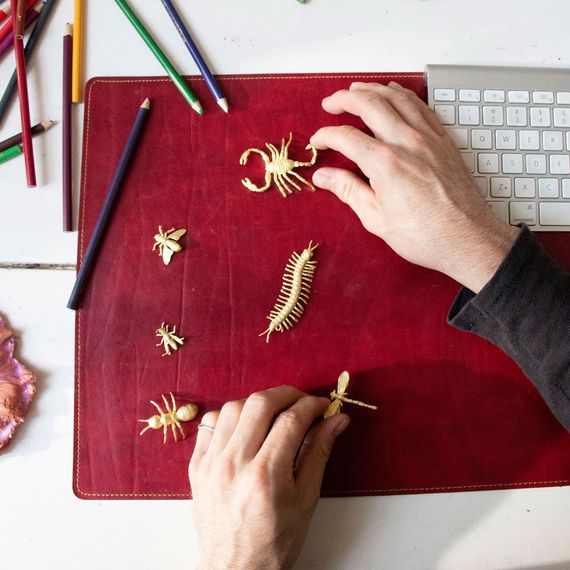
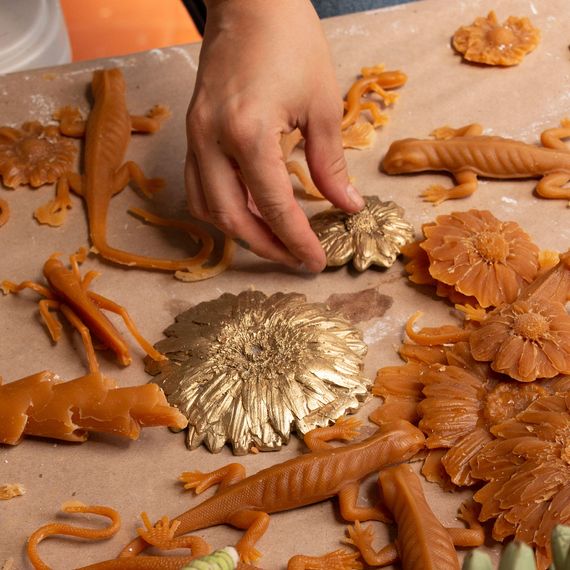
One of the designer’s longest material preoccupations has been with terra-cotta, a medium he’s revisited throughout his career. During his Fulbright research, Wolston studied its ubiquity and value in the landscape of Medellín. Because the material has been used for centuries in the city’s tiled roofs and is extensively used to build the informal low-income settlements that blanket the city’s hills, it’s viewed as a cheap, old-fashioned material. He noticed, for instance, that high-end flower shops would paint all their terra-cotta pots gray to look like concrete. “They became sort of brutalist or modern,” he says. In 2017, Wolston started making furniture out of terra-cotta in order to bring the raw, ancient material into the home. These earlier pieces — stout chairs that doubled as planters — were a hit, featured in the Times and exhibited at Design Miami. More recently, Wolston took up terra-cotta again to branch out into even wilder forms that pay homage to another ubiquitous element in Medellín: plants and flowers. They’re a billion-dollar industry in Colombia, and every day, Wolston sees trucks filled with sunflowers, gerbera daisies, and birds-of-paradise traveling between farms high in the hills to markets around his studio. Even his own backyard has been overtaken by a cidra vine (a fruit that’s like a cross between a potato and a mango) that a neighbor gave him. “I’m often overwhelmed by how alive Medellín is,” he says. All of these fruits and flowers appear in Wolston’s new “Flower Power” series, which is on view at the Future Perfect through June 30. The chairs and lamps are an eruption of clay blossoms adorned with giant bronze ants that he cast from toys he found at a dollar store. Wolston describes the collection as an “exquisite corpse” of blossoms, but it’s also the story of Medellín’s cityscape, condensed into stunningly expressive objects.
Chris Wolston’s latest collection of furniture and lighting, named “Flower Power,” references the lushness of Medellín, Colombia, where he lives and works. His studio employs ten local artisans who are experts in weaving, metalwork, and ceramics.
The chairs are made from terra-cotta sourced from Raquira, the pottery capital of Colombia, which is about 250 miles southeast of Medellín. Wolston left the furniture unglazed to show off the clay’s natural bright-orange hue. The parts of the chairs that someone would be in contact with (like the seat, back, and armrests) are made smooth to the touch using a pre-Columbian technique of burnishing, which involves rubbing the surface with a stone to seal it.
Most of the flowers and plants you see in the collection are a 1:1 replica of what’s growing in Medellin. Wolston made the embellishments from press molds.
The pendant light is composed of bronze casts of Guarumo trees, which reach 70 feet tall and have monstera-like foliage. “They’re sort of like Dr. Seuss trees,” Wolston says. If you look closely at the furniture, you’ll spy large ants, bees, spiders, and centipedes, which were cast from toys Wolston found at the dollar store near his studio.
Over time, Wolston’s furniture has become more expressive. The Nalgona series of wicker chairs, which he started making in 2018 and continues to add to, are woven from yaré, a vine that grows in Colombia and Venezuela.
Chris Wolston’s latest collection of furniture and lighting, named “Flower Power,” references the lushness of Medellín, Colombia, where he lives and works. His studio employs ten local artisans who are experts in weaving, metalwork, and ceramics.
The chairs are made from terra-cotta sourced from Raquira, the pottery capital of Colombia, which is about 250 miles southeast of Medellín. Wolston left the furniture unglazed to show off the clay’s natural bright-orange hue. The parts of the chairs that someone would be in contact with (like the seat, back, and armrests) are made smooth to the touch using a pre-Columbian technique of burnishing, which involves rubbing the surface with a stone to seal it.
Most of the flowers and plants you see in the collection are a 1:1 replica of what’s growing in Medellin. Wolston made the embellishments from press molds.
The pendant light is composed of bronze casts of Guarumo trees, which reach 70 feet tall and have monstera-like foliage. “They’re sort of like Dr. Seuss trees,” Wolston says. If you look closely at the furniture, you’ll spy large ants, bees, spiders, and centipedes, which were cast from toys Wolston found at the dollar store near his studio.
Over time, Wolston’s furniture has become more expressive. The Nalgona series of wicker chairs, which he started making in 2018 and continues to add to, are woven from yaré, a vine that grows in Colombia and Venezuela.
“Flower Power” is on view at the Future Perfect through June 30.
More From This Series
- The Artist Making Furniture Out of Felted Concrete
- An Installation of Clothes, Cardboard, and Plywood Takes Over the Japan Society
- A ‘Comical Dungeon’ Designed in VR Takes Over a Chinatown Gallery







